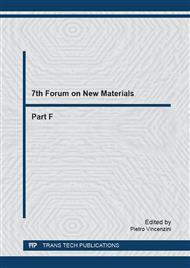[1]
T. H. Tran, J. Y. Choi, T. Ramasamy, D. H. Truong, C. N. Nguyen, H. G. Choi, Hyaluronic acid-coated solid lipid nanoparticles for targeted delivery of vorinostat to CD44 overexpressing cancer cells, Carbohyd. Polym. 114 (2014) 407-415.
DOI: 10.1016/j.carbpol.2014.08.026
Google Scholar
[2]
F. Sima, E. Axente, I. Iordache, C. Luculescu, O. Gallet, K. Anselme, Combinatorial matrix assisted pulsed laser evaporation of a biodegradable polymer and fibronectin for protein immobilization and controlled release, Appl. Surf. Sci. 306 (2014).
DOI: 10.1016/j.apsusc.2014.03.056
Google Scholar
[3]
I. I. Slowing, B. G. Trewyn, V. S. Y. Lin, Mesoporous silica nanoparticles for intracellular delivery of membrane-impermeable proteins, J. Am. Chem. Soc. 129 (2007) 8845-8849.
DOI: 10.1021/ja0719780
Google Scholar
[4]
N. W. S. Kam, Z. Liu, H. J. Dai, Functionalization of carbon nanotubes via cleavable disulfide bonds for efficient intracellular delivery of siRNA and potent gene silencing, J. Am. Chem. Soc. 127 (2005) 12492-12493.
DOI: 10.1021/ja053962k
Google Scholar
[5]
J. Park, S. Kurosawa, J. Watanabe, K. Ishihara, Evaluation of 2-methacryloyloxyethyl phosphorylcholine polymeric nanoparticle for immunoassay of c-reactive protein detection, Anal. Chem. 76 (2004) 2649-2655.
DOI: 10.1021/ac035321i
Google Scholar
[6]
T. Ito, J. Watanabe, M. Takai, T. Konno, Y. Iwasaki, K. Ishihara. Dual mode bioreactions on polymer nanoparticles covered with phosphorylcholine group. Colloid. Surf. B: Biointerfaces 50 (2006) 55-60.
DOI: 10.1016/j.colsurfb.2006.04.006
Google Scholar
[7]
J. Watanabe, K. Ishihara. Sequential enzymatic reactions and stability of biomolecules immobilized onto phospholipid polymer nanoparticles, Biomacromolecules 7 (2006) 171-175.
DOI: 10.1021/bm050544z
Google Scholar
[8]
J. Watanabe, K. Ishihara, Instantaneous determination via bimolecular recognition: Usefulness of FRET in phosphorylcholine group enriched nanoparticles, Bioconjugate Chem. 18 (2007) 1811-1817.
DOI: 10.1021/bc070095v
Google Scholar
[9]
Y. Goto, R. Matsuno, T. Konno, M. Takai, K. Ishihara, Polymer nanoparticles covered with phosphorylcholine groups and immobilized with antibody for high-affinity separation of proteins. Biomacromolecules 9 (2008) 828-833.
DOI: 10.1021/bm701161d
Google Scholar
[10]
Y. Goto, R. Matsuno, T. Konno, M. Takai, K. Ishihara, Artificial cell membrane-covered nanoparticles embedding quantum dots as stable and highly sensitive fluorescence bioimaging probes, Biomacromolecules 9 (2008) 3252-3257.
DOI: 10.1021/bm800819r
Google Scholar
[11]
J. Watanabe, K. Ishihara. Establishing ultimate biointerfaces covered with phosphorylcholine groups. Colloid. Surf. B: Biointerfaces 65 (2008) 155-165.
DOI: 10.1016/j.colsurfb.2008.04.006
Google Scholar
[12]
J. Watanabe, K. Ishihara, Single step diagnosis system using the FRET phenomenon induced by antibody-immobilized phosphorylcholine group-covered polymer nanoparticles, Sensor Actuat. B-Chem. 129 (2008) 87-93.
DOI: 10.1016/j.snb.2007.07.100
Google Scholar
[13]
T. Konno, J. Watanabe, K. Ishihara, Conjugation of enzymes on polymer nanoparticles covered with phosphorylcholine groups, Biomacromolecules 5 (2004) 342-347.
DOI: 10.1021/bm034356p
Google Scholar
[14]
K. Takei, T. Konno, J. Watanabe, K. Ishihara, Regulation of enzyme-substrate complexation by a substrate conjugated with a phospholipid polymer, Biomacromolecules 5 (2004) 858-862.
DOI: 10.1021/bm0344250
Google Scholar
[15]
D. J. Shi, M, Matsusaki, M. Akashi. Photo-tunable protein release from biodegradable nanoparticles composed of cinnamic acid derivatives. J. Control. Release. 149 (2011) 182-189.
DOI: 10.1016/j.jconrel.2010.08.009
Google Scholar
[16]
H. Shen, M. Liu, H.X. He, L. M. Zhang, J. Huang, Y. Chong Y, ACS Appl. Mater. Inter. 4 (2012) 6317-6323.
Google Scholar
[17]
W. Feng W, S. P. Zhu, K. Ishihara, J. L. Brash, Adsorption of fibrinogen and lysozyme on silicon grafted with poly(2-methacryloyloxyethyl phosphorylcholine) via surface-initiated atom transfer radical polymerization, Langmuir 21 (2005) 5980-5987.
DOI: 10.1021/la050277i
Google Scholar
[18]
W. Feng W, S. P. Zhu, K. Ishihara, J. L. Brash, Protein resistant surfaces: Comparison of acrylate graft polymers bearing oligo-ethylene oxide and phosphorylcholine side chains, Biointerphases 1 (2006) 50-60.
DOI: 10.1116/1.2187495
Google Scholar
[19]
K. Ishihara, H. Nomura, T. Mihara, K. Kurita, Y. Iwasaki, N. Nakabayashi. Why do phospholipid polymers reduce protein adsorption? J. Biomed. Mater. Res. 39 (1998) 323-330.
DOI: 10.1002/(sici)1097-4636(199802)39:2<323::aid-jbm21>3.0.co;2-c
Google Scholar
[20]
K. Ishihara, N. P. Ziats, B. P. Tierney, N. Nakabayashi, J. M. Anderson. Protein adsorption from human plasma is reduced on phospholipid polymers, J. Biomed. Mater. Res. 25 (1991) 1397-1407.
DOI: 10.1002/jbm.820251107
Google Scholar
[21]
Y. Inoue, K. Ishihara. Reduction of protein adsorption on well-characterized polymer brush layers with varying chemical structures. Colloid. Surf. B: Biointerfaces 81 (2010) 350-357.
DOI: 10.1016/j.colsurfb.2010.07.030
Google Scholar
[22]
S. Sakata, Y. Inoue, K. Ishihara, Quantitative evaluation of interaction force between functional groups in protein and polymer brush surfaces, Langmuir 30 (2014) 2745-2751.
DOI: 10.1021/la404981k
Google Scholar
[23]
S. Sakata, Y. Inoue, K. Ishihara, Molecular interaction forces generated during protein adsorption to well-defined polymer brush surfaces, Langmuir 31 (2015) 3108-3114.
DOI: 10.1021/acs.langmuir.5b00351
Google Scholar
[24]
K. Ishihara, T. Ueda, N. Nakabayashi, Preparation of phospholipid polymers and properties as hydrogel membranes. Polym. J. 23 (1990) 355-360.
DOI: 10.1295/polymj.22.355
Google Scholar
[25]
T. Ueda, H. Oshida, K. Kurita, K. Ishihara, N. Nakabayashi, Preparation of 2-methacryloyloxyethyl phosphorylcholine copolymers with alkyl methacrylates and their blood compatibility, Polym. J. 24 (1992) 1259-1269.
DOI: 10.1295/polymj.24.1259
Google Scholar
[26]
W. X. Chen, Y. Inoue, K. Ishihara. Quantitative evaluation of interaction force of fibrinogen at well-defined surfaces with various structures. J. Biomat. Sci. Polym. Ed. 25 (2014) 1629-1640.
DOI: 10.1080/09205063.2014.936925
Google Scholar
[27]
K. Ishihara, Y. Iwasaki, N. Nakabayashi, Polymeric lipid nanosphere constructed of poly(2-methacryloyloxyethyl phosphorylcholine-co-n-butyl methacrylate), Polym. J. 31 (1999) 1231-1236.
DOI: 10.1295/polymj.31.1231
Google Scholar
[28]
B. Byambaa, T. Konno, K. Ishihara, Cell adhesion control on photoreactive phospholipid polymer surfaces, Colloid. Surf. B: Biointerfaces 99 (2012) 1-6.
DOI: 10.1016/j.colsurfb.2011.08.029
Google Scholar
[29]
B. Byambaa, T. Konno, K. Ishihara. Detachment of cells adhered on the photoreactive phospholipid polymer surface by photoirradiation and their functionality. Colloid. Surf. B: Biointerfaces 103 (2013) 489-495.
DOI: 10.1016/j.colsurfb.2012.11.008
Google Scholar
[30]
J. Nakanishi, Y. Kikuchi, T. Takarada, H. Nakayama, K. Yamaguchi, M. Maeda, Photoactivation of a substrate for cell adhesion under standard fluorescence microscopes, J. Am. Chem. Soc. 126 (2004) 16314-16315.
DOI: 10.1021/ja044684c
Google Scholar


